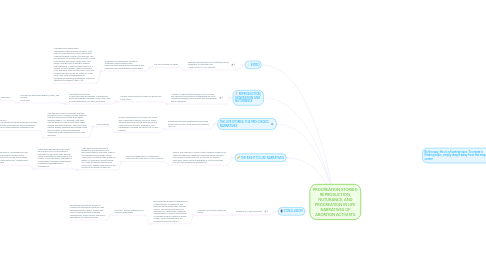
1. INTRO
1.1. There are approximately 1000 attentially active supporters on each side and • hard core of 10 to 20 activists.
1.1.1. pro-life movement in Fargo
1.1.1.1. dimensions of experiences "private" in American culture intersect with particular social and historical conditions that distinguish the memberships of each group.
1.1.1.1.1. "Callahan and Callahan write: The general debate has seen an effort, on all sides, to make abortion fit into some overall coherent scheme of values, one that can com- bine personal convictions and consistency with more broadly held social values. Abor- tion poses a supreme test in trying to achieve that coherence. It stands at the juncture of a number of value systems, which continually joust with each other for dominance, but none of which by itself can do full justice to all the values that, with varying degrees of insistence and historical rootedness, clamor for attention and respect. (1984: 219) "
2. REPRODUCTION, GENERATION AND NUTURANCE
2.1. Surveys of representative samples of pro-life and pro-choice activists have not established any clear correlations between such activity and conventional social categories.
2.1.1. The pro-choice activists cluster in a group born in the 1940s.
2.1.1.1. life stories indicate that ict with the social movements of that period, particularly the second wave of fem- inism, was a central experience for nearly all of diem.
2.1.1.1.1. Activists san and divide religious, ethnic, and occupa- tional lines.
3. THE LIFE STORIES: THE PRO-CHOICE NARRATIVES
3.1. women activists who organized to defend the Fargo abortion clinic; most were born between 1942-52.
3.1.1. strong commitment to pro-choice ac- tivism was connected to specific life-cycle events, generally having to do with experiences and choices around sexuality, pregnancy, and childbearing, including the choice not to have children.
3.1.1.1. Kay Belleview
3.1.1.1.1. "And the way I came to feminism was that through all of this, I became acutely aware of how little physicians actually knew about women's bodies... So I became a real advo- cate for women to stand up for their rights, starting with breastfeeding. " the feeling that doctors weren't educated well enough on the inner workings of the body fueled the disapproval of the abortion process for Kay Belleview
4. THE RIGHT TO LIFE NARRATIVES
4.1. there is one scripture in Isaiah 44 that I especially pray for my family and that says 'I knew you before you were formed in your mother's womb. Fear not, for you are my witness.' " often bible verses can be interpreted to fit a purpose they may not have originally be intended for
4.1.1. move from wage labor to motherhood occurred in the late 1970s or more recently
4.1.1.1. "They paint the job world as so glamorous, as if women are all in executive positions. But really, what is the average women doing? Mostly office work, secretarial stuff. When you watch TV, there aren't women being pic- tured working at grocery store check-outs." speaks volumes about job prospects for women at this time
4.1.1.1.1. In this view, legal abortion represents the loss of a locus of unconditional nurturance in the social order and the steady penetration of the forces of the market. In concrete terms, the threat is constituted in the public endorsement of sexuality disengaged from motherhood.
5. CONCLUSION
5.1. biological do- main of activity
5.1.1. Activists, as narrators of their life stories,
5.1.1.1. By casting two possible interpretations of this situation in opposition, the abortion debate masks their common roots in, and circumvents effective resistance to, problematic conditions engendered by a central contradiction for women living in a system in which mother- hood and wage labor are continually placed in conflict.
5.1.1.1.1. the repro- ductive experiences of different generations
